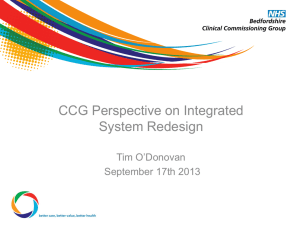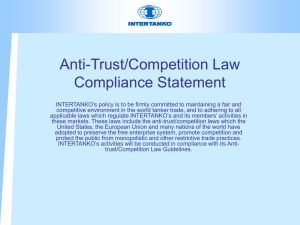Multimedia Broadcast/Multicast Service (MBMS)
advertisement
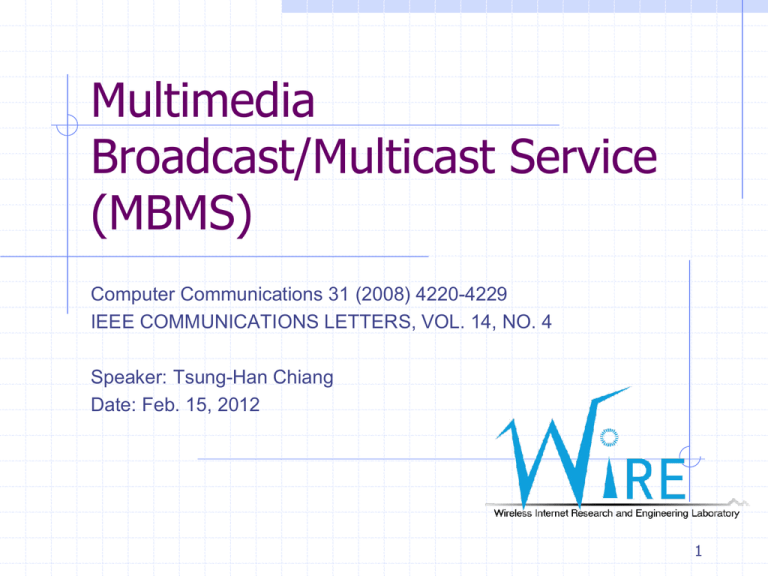
Multimedia Broadcast/Multicast Service (MBMS) Computer Communications 31 (2008) 4220-4229 IEEE COMMUNICATIONS LETTERS, VOL. 14, NO. 4 Speaker: Tsung-Han Chiang Date: Feb. 15, 2012 1 Outline Introduction Multicast/Broadcast Services in 3GPP MBMS Architecture BM-SC Architecture MBMS Operations Mobility Management and Security Mechanism in MBMS Dynamic Rekeying in 3GPP MBMS MBMS without Dynamic Rekeying Dynamic Rekey: Logical Key Hierarchy with Height 3 Dynamic Rekey: Logical Key Hierarchy with Degree 4 2 Multicast/Broadcast Services in 3GPP Cell broadcast service (CBS) CBS is based on short message service (SMS) developed in GSM. It provides only text-based service. Multimedia Broadcast/Multicast Service (MBMS) It provides not only messaging services but also multimedia services. It is also compatible with Internet multicast services. 3 MBMS Architecture 4 BM-SC Architecture The BM-SC is the entry point in 3GPP network for MBMS services. 5 BM-SC Architecture (cont.) The membership function authorizes the UEs that want to activate MBMS services. The session and transmission function schedules the transmission of MBMS sessions. The proxy and transport function acts as a proxy agent for signaling and MBMS data between other functions and GGSN. The service announcement function announces available MBMS services. The security function distributes MBMS security keys for data integrity and confidentiality. 6 MBMS Operations (1/3) The broadcast mode is same except that it does not include steps (1) subscription, (3) joining, and (8) leaving. 7 MBMS Operations (2/3) In Step (1) subscription, users establish connection to service providers in order to receive MBMS related information. The subscription records will be kept in BMSC. Users can find out what services are provided by Step (2) service announcement/discovery, which enables users to discover the range and capability of the MBMS content providers. If a mobile station is interested in the service, it will subscribe to the service by using Step (3) joining, which establish signaling connections between the UE and the core network. The UE will send IGMP join message in the 8 activated PDP context to GGSN. MBMS Operations (3/3) Step (4) session start will establish the necessary data bearer. The process is initiated by BM-SC when BM-SC is ready to send MBMS data. The UEs then will be notified of incoming MBMS data by Step (5) MBMS notification. After that, MBMS data is transmitted, which is shown as Step (6) data transfer. Step (7) session stop is invoked once the BM-SC has no data to send. After that, the related bearers are released. In Step (8) leaving, an UE will send IGMP leave message to the serving GGSN if the UE initiates the leaving process. 9 Mobility Management and Security Mechanism in MBMS Because mobility management in the original 3GPP PS domain is well defined, the mobility management in MBMS is combined with the one developed in 3GPP PS domain. Unlike mobility management, the security mechanisms developed in the original 3GPP PS domain cannot meet the requirements of the MBMS services. Therefore, 3GPP has developed specific security techniques for MBMS, including authentication, key distribution, and MBMS data protection. 10 Mobility Management and Security Mechanism in MBMS Both BM-SC and UE own the following keys. MBMS Request Key (MRK): It is mainly used for authentication. MBMS User Key (MUK): It is used to protect the distribution of MSK. MBMS Service Key (MSK): It is used to protect a certain MBMS session. It is also used to protect the distribution of MTK. MBMS Traffic Key (MTK): It is used to encrypt/decrypt MBMS traffic 11 MBMS without Dynamic Rekeying The KS (BM-SC) and all group members share the same MTK and MSK. The KS also shares the MUK and MRK with each individual user. When a user joins the multicast group, the degree of the key tree is increased. 12 Dynamic Rekey: Logical Key Hierarchy with Height 3 As aforementioned discussion, MRK is used for authentication. MTK is used to protect the MBMS traffic. MTK is protected by MSK, which is further protected by MUK. MTK, MSK, and MUK essentially are the group key, auxiliary key, and individual key. 13 Dynamic Rekey: Logical Key Hierarchy with Degree 4 In prior studies, the authors have proved that to minimize rekeying cost, the degree of the key tree should be set as 4. When the number of users increases, the height of the key tree is increased. 14

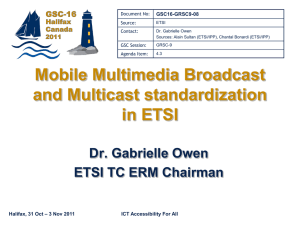
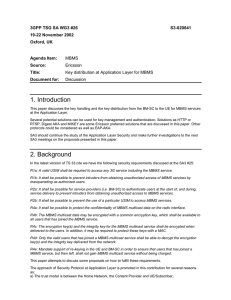
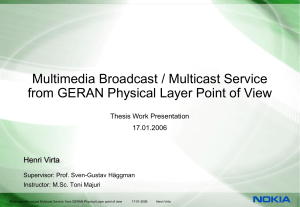




![JOINING procedure (TJ) (315) (330) K [MccH] SERVICE](http://s2.studylib.net/store/data/018313512_1-915737b58b7b166344d1dddbce6fda9f-300x300.png)

